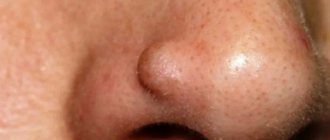Types and classification
In accordance with the international classification of cancer stages (TNM) from 2022, several types of mucosal melanoma are distinguished.
By tumor prevalence:
| T3 | Neoplasms limited to the mucous membrane and lying directly under the soft tissues, regardless of the largest size or thickness |
| T4a | Neoplasms spread to bone structures, deep-lying soft tissues, skin, cartilage |
| Т4b | Tumors spread to the hard muscle, zygomatic bone, cranial nerves, carotid artery |
Based on the presence of regional metastases, tumors are divided into three types:
| Nx | The presence of regional metastases cannot be assessed |
| N0 | There are no regional metastases |
| N1 | Regional metastases are present |
Based on the presence of distant metastases, melanoma of the mucous membranes can be of three types:
| cm0 | No distant metastases were found |
| sM1 | Distant metastases are present |
| рМ1 | Histologically confirmed distant metastases are present |
Prevention and early detection of skin melanoma
Reducing the risk of developing melanoma:
- regular self-examination of the skin. Particular attention should be paid to moles at the beginning and end of summer. If there are any signs of their degeneration, you should consult a doctor;
- if there are a large number of moles, large pigment spots or atypical nevi, excessive solar insolation should be avoided and examined by specialists annually;
- exposure to ultraviolet radiation on the skin, both solar and artificial (solariums), should be limited;
- You should not sunbathe between 10 a.m. and 3 p.m. This is the most dangerous time, when the sun is most active and the likelihood of quickly getting burned is highest. At this time, sunscreens are also ineffective. They protect the skin from burns, but do not reduce the risk of melanoma and skin cancer;
- Do not stay in the sun without protective equipment for no more than 30 - 40 minutes. The most reliable and simplest way of protection remains our clothing, hats that protect the skin of the face, and scarves that cover the neck. In this case, preference should be given to cotton and loose-fitting clothing.
In approximately half of cases, melanoma develops from pigmented nevi. The true incidence of melanomas from nevi has not yet been established. However, as practice shows, melanoma can develop from any type of pigmented nevus. Therefore, when removing them, postoperative histological examination is mandatory.
The greatest dangers for the development of melanoma are giant pigmented nevi, atypical (dysplastic) nevi, and limited precancerous melanosis of Dubreuil.
A giant pigmented nevus can be localized on any part of the body, but most often on the limbs and torso. Sometimes satellite nevi may be observed. The neoplasm is a highly pigmented congenital spot of large size, the color of which varies from gray to black, often covered with hair, its surface may be uneven, warty with cracks. Malignancy is observed in 1.8-13% of cases.
Atypical (dysplastic) nevi
Atypical (dysplastic) nevi occur at different ages. The average size of the neoplasm usually exceeds that of ordinary acquired nevi (more than 5 mm). Atypical nevi can be single or often multiple. The shape of the neoplasm is irregular (ovoid), the surface is usually flat, the contours are not clear with a blurred edge.
An atypical nevus has uneven pigmentation (the center of the nevus is one color, the edges are another) and wide variations in color (from light gray to dark brown and pink). Atypical nevi are the most common precursors of melanoma and are clinical markers of high risk of developing melanoma.
Atypical nevus syndrome
Atypical nevus syndrome is a combination of a large number of irregularly shaped nevi, including atypical ones, and cases of familial melanoma. This syndrome requires examinations by an oncologist every 6 months throughout life.
Limited precancerous Dubrey's melanosis (melanosis maligna)
The disease begins with a small brown spot that slowly spreads around the periphery, which can reach a size of 6 cm or more. A characteristic feature is uneven coloring, the presence of areas from light brown to bluish-black.
Initially, a spot with uneven edges does not rise above the surface of the skin, is not compacted, and the skin texture is not changed. Subsequently, small papules and plaques may appear on the surface. Develops mainly in older people.
The incidence of melanoma against the background of Dubreuil's melanosis reaches 30-80% with an incubation period of 3 to 20 years.
Symptoms
The disease is most dangerous because in about a third of cases there are no signs, that is, melanoma is asymptomatic. The other two-thirds of patients note the following first signs of the disease:
- ulceration of the mucous membrane;
- bleeding in the area affected by the tumor;
- nodular or mocular neoplasm, which can have various shades - reddish, brown, purple, black, gray, white;
- first noted pain caused by wearing orthopedic devices in the oral cavity.
Benefits of skin cancer treatment at MelanomaUnit
MelanomaUnit is a branch of an Israeli medical center, the basic principles of which are the highest quality of services, experienced specialists and maximum comfort for patients.
We use equipment from the best manufacturers of medical equipment, certified time-tested drugs and innovative technologies aimed at maintaining health.
Our specialists constantly improve their skills by undergoing training in Russia and abroad. MelanomaUnit doctor is to achieve the best result for the patient.
Make an appointment
Diagnostic methods
In order not to miss this disease and to identify it at the earliest possible stage, you need to regularly visit an otolaryngologist and dentist for routine preventive examinations of the mucous membranes of the oral cavity and ENT organs.
The following laboratory and hardware techniques are also used to detect pathology:
- MRI, CT, ultrasound (examination of secondary damage to areas in which regional and distant metastases are located is carried out);
- biopsy, after which the resulting biomaterial is sent to the laboratory for cytological and histological examination;
- determination of the presence of mutations in the BRAF and C-KIT genes.
Melanoma
21858 December 14
IMPORTANT!
The information in this section cannot be used for self-diagnosis and self-treatment.
In case of pain or other exacerbation of the disease, diagnostic tests should be prescribed only by the attending physician. To make a diagnosis and properly prescribe treatment, you should contact your doctor. Melanoma: causes, symptoms, diagnosis and treatment methods.
Definition _
Melanoma is a malignant tumor that arises from pigment cells (melanocytes) of the skin. Over the past 50 years, there has been an increase in incidence. And although melanoma accounts for no more than 5% of cases of all forms of malignant skin tumors, it is responsible for at least 80% of deaths among all types of skin cancer.
Melanocytes (pigment cells) are normally present in various organs, including the meninges, choroid, mucous membranes of the gastrointestinal tract, genital tract, etc., so a primary tumor (melanoma) can arise in any of these organs. In this case, the tumor is called melanoma of the corresponding organ, for example, melanoma of the ileal mucosa or melanoma of the choroid.
In the presence of distant metastases, the primary focus on the skin or in other organs may not be detected, then such a disease is called metastases of melanoma without an identified primary focus.
Causes of melanoma
Risk factors for non-hereditary forms of skin melanoma may include:
- exposure to ultraviolet radiation on the skin;
- the presence of more than 10 dysplastic nevi on the skin (a dysplastic nevus is a transitional form from a mole to melanoma);
- the presence of more than 100 common acquired nevi on the skin (a nevus (mole, birthmark) is a benign tumor-like neoplasm consisting of melanocytes);
- periodic sunburn of the skin in childhood and adolescence;
- the presence of a giant or large congenital nevus (more than 5% of the body surface area);
- family history of cutaneous melanoma;
- use of PUVA therapy (for psoriasis and other chronic dermatoses);
- xeroderma pigmentosum (xeroderma is a hereditary skin disease characterized by increased sensitivity to ultraviolet radiation);
- congenital or acquired immunodeficiency (after organ transplantation, taking immunosuppressants).
Risk factors for melanoma of other sites, such as mucosal melanoma, have not been sufficiently studied.
Melanoma has a high tendency to metastasize through hematogenous (with blood flow through the vessels) and lymphogenous routes (through the lymphatic routes to the nearest and distant lymph nodes).
In some cases, distant foci of tumor cells may appear 15 to 20 years after treatment. Hematogenous metastases are found more often in the lungs, liver, brain and bones, but metastatic damage to any organs is possible.
The spread of melanoma throughout the skin in the form of a cluster of tumor cells or a tumor nodule at a distance of no more than 2 cm from the primary tumor (satellites) is an unfavorable prognostic factor.
Classification of the disease
Malignant melanoma of the skin:
- malignant melanoma of the lip;
- malignant melanoma of the eyelid;
- malignant melanoma of the ear and external auditory canal;
- malignant melanoma of the scalp and neck;
- malignant melanoma of the trunk;
- malignant melanoma of the upper limb;
- malignant melanoma of the lower extremity;
- malignant neoplasm of the vulva;
- malignant neoplasms of the penis;
- malignant neoplasms of the scrotum.
Melanoma metastases without an identified primary focus:
- secondary and unspecified malignant neoplasm of lymph nodes;
- secondary malignant neoplasm of the respiratory and digestive organs;
- secondary malignant neoplasm of other localizations;
Melanoma of the mucous membranes:
- malignant neoplasms of the lip, oral cavity and pharynx;
- malignant neoplasms of the digestive organs;
- malignant neoplasm of the nasal cavity and middle ear;
- malignant neoplasm of the paranasal sinuses;
- malignant neoplasm of the larynx;
- malignant neoplasms of the female genital organs;
- malignant neoplasms of the penis of unspecified localization.
Melanoma in situ
(cancer in the very initial stage, when there is only a layer of malignant cells that does not extend beyond the mucous membrane or surface of the skin and does not penetrate deep into the wall of the organ):
- melanoma in situ of the lips;
- melanoma in situ of the eyelid, including eyelid adhesion;
- melanoma in situ of the ear and external auditory canal;
- melanoma in situ of other and unspecified parts of the face;
- melanoma in situ of the scalp and neck;
- melanoma in situ of the trunk;
- melanoma in situ of the upper limb;
- melanoma in situ of the lower limb;
- melanoma in situ of unspecified localization.
The following levels of penetration (invasion)
of melanoma are distinguished:
Level 1 - tumor within the epithelial layer (non-invasive);
Level 2 - the tumor grows through the basement membrane and infiltrates the papillary layer of the dermis; metastases develop in 5% of cases;
Level 3 - tumor infiltrating the reticular layer of the dermis at the level of the sweat glands; metastasis in 32–50% of cases;
Level 4 - tumor infiltrating the reticular layer of the dermis; metastases are found in 60% of patients;
Level 5 - the tumor grows into the subcutaneous fat and or there are satellites within 2 cm of the primary tumor; 66% of patients develop metastases to regional lymph nodes.
Melanoma symptoms
There are four most common clinical forms of melanoma:
- superficial spreading
- nodal,
- lentigo melanoma,
- acral-lentiginous.
The most common type of skin melanoma is superficial spreading melanoma, which has a relatively favorable prognosis.
This melanoma goes through two phases of development. The radial growth phase, which can last several years, is characterized by a low probability of metastasis. The vertical growth phase, when tumor cells invade the reticular and subcutaneous fat layers, is characterized by a high probability of metastasis. The superficial spreading form of melanoma develops on apparently unchanged skin or against the background of a pigmented nevus. A small flat nodule of dark, almost black color, 1–3 mm in diameter, appears. Gradually it becomes denser, grows, its surface becomes uneven, and its outlines become irregular—“geographical.”
Superficial spreading melanoma can come in several colors and always evolves over time. The dimensions most often exceed 0.5 cm.
Nodular melanoma is represented by a dense node with a bumpy surface and a tendency to grow vertically. Its surface ulcerates, bleeds and becomes crusty. This is the most unfavorable type of tumor in terms of prognosis.
Lentigo melanoma is a type of melanoma characterized by a long course. It goes through two phases of development, and the first phase (radial growth) can last 10 years or more. Lentigo melanoma often forms on open areas of the body, less often affects the skin of the back and lower extremities and is an irregularly shaped spot. The prognosis is more favorable than with superficial spreading melanoma.
Acral-lentiginous melanoma is localized in the distal parts of the extremities (skin of the hands and feet, in the area of the nail bed and proximal periungual fold), has a more aggressive course, and metastasizes more often and faster. Due to its specific localization, in most cases it is diagnosed already at the stage of invasive (penetrating) growth.
Melanoma is easily injured and bleeds, it can itch and create an uncomfortable sensation of swelling. In some cases, melanoma manifests itself with enlarged lymph nodes.
When melanoma is localized on the mucous membranes of the nasal cavity and paranasal sinuses, the disease in the early stages proceeds unnoticed, sometimes only the patient complains of nasal congestion and nosebleeds.
Diagnosis of melanoma
The diagnosis of melanoma is established on the basis of anamnesis, data from a physical examination and dermoscopic examination, and data from the study of biopsy material.
To clarify the diagnosis, identify concomitant diseases and metastases, additional laboratory and instrumental studies may be recommended:
- clinical blood test with determination of hemoglobin concentration, number of erythrocytes, leukocytes and platelets, hematocrit and erythrocyte indices, leukoformula and ESR;
Treatment
When treating such a disease, a multidisciplinary, that is, an integrated approach is used. The following treatment methods are used in various combinations:
- surgical intervention in which the primary lesion is removed, and then the issue of the need for cervical lymph node dissection (removal of lymph nodes in the neck) is decided;
- adjuvant radiation therapy;
- adjuvant chemotherapy;
- immunotherapy (if the presence of a mutation in the BRAF and C-KIT genes is confirmed).
Observation and examination after treatment
After radical surgery, local tumor recurrences are extremely rare. However, given that melanoma metastases can develop many years after removal of the primary tumor, lifelong monitoring by an oncologist is necessary.
Therefore, patients who have completed treatment must undergo an examination, which includes:
- examination of all skin;
- palpation of regional lymph nodes;
- X-ray examination of the chest organs;
- Ultrasound of the abdominal organs;
- general and biochemical blood test;
- determination of the level of lactate dehydrogenase (LDH) in blood serum (for melanoma with metastases).
In some cases, it is necessary to use other examination methods (MRI of the brain, CT of the abdominal and thoracic cavities, osteoscintigraphy, etc.).
During the first two years, control examinations are carried out every 3-6 months. During the third year every 4-12 months, then annually.
Stages of the disease
We suggest you familiarize yourself with the stages of the disease. The staging table is based on the International Cancer Staging (TNM) classification. Each stage is assigned to certain types of melanoma, which we presented above in the tables.
| Stage | T | N | M |
| III | T3 | N0 | M0 |
| IVa | T4a T3-T4a | N0 N1 | M0 |
| IVb | T4b | Any N | M0 |
| IVc | Any T | Any N | M1 |
Prevention
Control of pigmented skin formations is especially important for persons diagnosed with lentigo maligna and atypical nevus syndrome. Surgical removal of blue nevi, Reed's nevi (pigmented spindle cell nevus), and hairy birthmarks is recommended.
After a microscopic examination, for the purpose of prevention, it is also possible to remove ordinary moles, especially those with a diameter exceeding 5 mm and located in places prone to injury (palms, feet, skin folds). A laser can be used to remove them. Moles that have passed the test are also allowed to be removed for cosmetic purposes.
Dr. Mare Aarne
Forecast
The survival rate of patients who received combination treatment is 4.5-49.2%.
Factors that significantly influence survival prognosis:
- are there regional metastases;
- are there distant metastases;
- what stage – IVa, IVb, IVc;
- invasion (germination) of the neoplasm into the underlying tissues;
- non-radical (incomplete) surgical removal of the primary focus of the disease;
- localization of the tumor (for example, in patients with MSO of the oral cavity, regional metastases appeared in 36.4% of cases, in patients with MSO of the nasal cavity and paranasal sinuses - in 7.8% of cases).
Some epidemiological aspects (statistics) of skin melanoma
Melanoma occurs approximately 10 times less frequently than skin cancer and accounts for 1–4% of the total structure of human malignant neoplasms. This tumor is one of the most malignant and is characterized by rapid growth and early rapid lymphogenous and hematogenous metastasis.
About half of melanoma cases occur in people aged 30–50 years. It is extremely rare that a tumor can develop in children. Melanoma can develop on the skin of any area of the body, but its favorite localization in women is the lower extremities (lower leg), and in men - the torso (back). In older people, the tumor is somewhat more often localized on the skin of the face.
Over the past ten years, the annual number of cases of skin melanoma in Belarus has increased 1.5 times: from 461 cases in 2001 to 676 in 2010. In general, every 6-8 years the number of patients with melanoma doubles in the world.
In approximately half of the cases, melanoma develops on apparently healthy skin, in other cases - on the site of congenital or acquired pigmented nevi and Dubreuil's melanosis.
What is oncology and how does it occur?
Oncology begins with the appearance in the body of just one mutated or altered cell. It is formed due to the influence of various diseases, exposure to sunlight, disruption of the immune system and hereditary characteristics; it grows, develops and gradually forms a tumor. Most of these cells are dealt with by the immune system - it identifies and destroys them, but some of them manage to escape the attention of our natural defenses or resist it. Unlike ordinary, healthy cells of the human body, which are born, work and die in a strictly designated place for them, cancer cells are able to move throughout the body. They enter the circulatory or lymphatic systems. The lymphatic system complements the cardiovascular system. The lymph circulating in it - the intercellular fluid - washes all the cells of the body and delivers the necessary substances to them, taking away waste. In the lymph nodes, which act as “filters,” dangerous substances are neutralized and removed from the body, transferred to other tissues, fixed in them and form metastases - new foci of the disease.
Most skin cancers begin in the top layer of the skin, the epidermis, which contains 3 main types of cells:
- flat, located in the upper area: form the main protective layer and are constantly renewed;
- basal, located in its lower part: constantly dividing and forming new cells, which move upward and turn into flat ones;
- melanocytes: produce a dark pigment - a substance that colors the skin yellowish or brownish, protecting its deeper layers from the harmful effects of the sun.
Most melanomas still produce melanin, which gives them a dark brown or black coloration. New growths in which this compound is not produced are pink, light brown or even white.
These tumors can develop anywhere, but most often occur on the neck and face, as well as the chest and back in men, and on the legs in women. The risk of developing them in these areas is lower in dark-skinned people - they usually suffer from this type of cancer on the palms, soles of the feet and tissues located under the nails.










